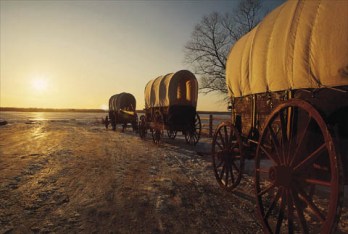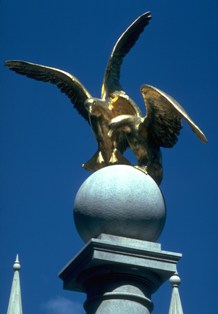Westward Migration
- Return to general Mormon history article.
- Return to previous time period.
The Trek West
The trek of the Mormon Pioneers is one of the most inspiring and heartbreaking episodes in U.S history. The Mormons, U.S. citizens, left their homes and marched thousands of miles from Nauvoo, Illinois on the Mississippi River, to the Salt Lake Valley, in Utah. They were literally driven out of their own country since Utah was then still part of Mexico. For many, the journey did not end there, as the Mormon Church continued to settle all the surrounding regions from Chihuahua, Mexico to Alberta, Canada.
As the first Mormon pioneers left Nauvoo in February of 1846, another group of Latter-day Saints left New York City on board the Brooklyn, under the leadership of Samuel Brannan, bound for Yerba Buena (now San Francisco), in California, from where they would make the trek to Utah. The journey lasted six months.
By June 14, the Saints traveling overland arrived in Council Bluffs, Iowa, which they named Kanesville. Later they established Winter Quarters[1] across the river in Nebraska. By the end of the year, all Mormons who chose to follow the Quorum of the Twelve Apostles had left Illinois and were established in Winter Quarters, or the other temporary settlements. The winter was harsh and many were near starving. In early 1847, Brigham Young received a revelation on how to organize for the journey west. It counseled the Saints to established groups with captains and to make way-stations along the journey [2]. It also commanded them to sing songs and dance when they were happy and to pray when they were sad. It was in Iowa that one Mormon pioneer, William Clayton, overjoyed to hear news that his wife had just given birth, wrote the famous song “Come, Come Ye Saints,” which the Mormons would sing as they crossed the plains.
While in Council Bluffs, the United States Army approached Brigham Young. Ironically, while the government refused to defend or help the driven Mormons, it now requested 500 men to form a battalion for fighting in the U.S.-Mexican War. Though recognizing the irony of the situation and the trials it could cause, Brigham Young agreed since the soldier’s pay would help the impoverished pioneers. The five-hundred men of the Mormon Battalion soon left. Brigham Young prophesied that they would not see battle, but would eventually rejoin their families safely in Utah. That prophesy came true, but only after the men, and a few women who refused to abandon their husbands, endured the longest infantry march in U.S. history, over 2,000 miles. Eventually they arrived in San Diego, where a monument still stands to them. Along the way, the only trouble they had was with a disrespectful captain assigned to watch them, sickness, which caused some to leave and go to Pueblo, Colorado, and a skirmish with some Bison. The Mormon Battalion achieved not only helping the pioneers, but also kicking off the California Gold Rush of 1849, when several of them found gold as Sutter’s Mill while trying to earn enough money to go to Utah.In April of 1847, Brigham Young and his advance party left Winter Quarters. Other groups followed behind. This group blazed the Mormon Trail to Utah. The first scouts arrived in the Salt Lake Valley on July 21, 1847, but the main party arrived on July 24, 1847, which is celebrated as Pioneer Day in Utah. On that day, Brigham Young, confined to a wagon because of illness, sat up in his bed, looked at the Salt Lake Valley and said, “This is the place, drive on.”
The men and women of this company immediately planted crops to have fresh wheat before the winter. Brigham Young and others chose and dedicated the land for the Salt Lake Temple and returned to Winter Quarters. They arrived just before winter. That December in Council Bluffs, Iowa, the members of the Church sustained and accepted Brigham Young as the second President of the Church, and a prophet, seer, and revelator to the whole world.
The next spring, Brigham Young and other companies returned to Utah. Crisis gripped the new colonies as swarms of crickets, later named Mormon crickets, attacked their crops in June 1848. After much prayer and fasting, flocks of seagulls came and ate all the crickets, more than they normally should have. The Mormon pioneers recognized this as a miracle. Later a monument was erected to this event on Temple Square in Salt Lake City and the seagull became the state bird.
The next few years passed similarly as more and more Mormon pioneers crossed the Great Plains and came to Utah. Towns were established all throughout Utah. Missionary work continued and by the late 1840s and 1850s, there were more Mormons in Europe, with over 17,000 in England alone, than in America. The Book of Mormon was translated into every major European language as well as Hawaiian, where the Church grew quickly, too. The Mormon Church started a newspaper, The Deseret News, and established churches, schools, and a government. In September of 1850, President Millard Fillmore named Brigham Young as territorial governor. The Mormons named a town, Fillmore, after him. In 1851, the Church established the University of Deseret, which is now called the University of Utah.
In August of 1852, the Church publicly announced for the first time the practice of polygamy, or plural marriage. This issue became the focus for all attacks and persecution of Mormonism for the next forty years. Nevertheless, the Mormons continued to establish towns throughout Utah, Arizona, Nevada, Wyoming, Colorado, and Idaho. To assist poor Mormons coming from Europe, the Church established in 1849 the Perpetual Emigration Fund. This gave money to immigrating Mormons and helped them to get established in the West. Once they could start making money, they paid back what they had taken. That money was then given to other immigrants. The PEF helped tens of thousands move to Utah. Eventually, to allow more settlers to come, the Church started having some pioneers use handcarts. While most Mormons made it safely with handcarts, two companies, the Martin and Willie Handcart Companies of 1856, got a late start and used green wood for their wheels. Since the wood was not properly cured, the wheels broke frequently. Delays from this and an early winter forced them to hole up in Martin’s Cove in western Wyoming. Many died of exposure before rescue efforts organized by Brigham Young saved them in November of 1856. Thousands of Mormons continued to immigrate with handcarts and wagons until the transcontinental railroad was finished in 1869.
- Proceed to next time period.

